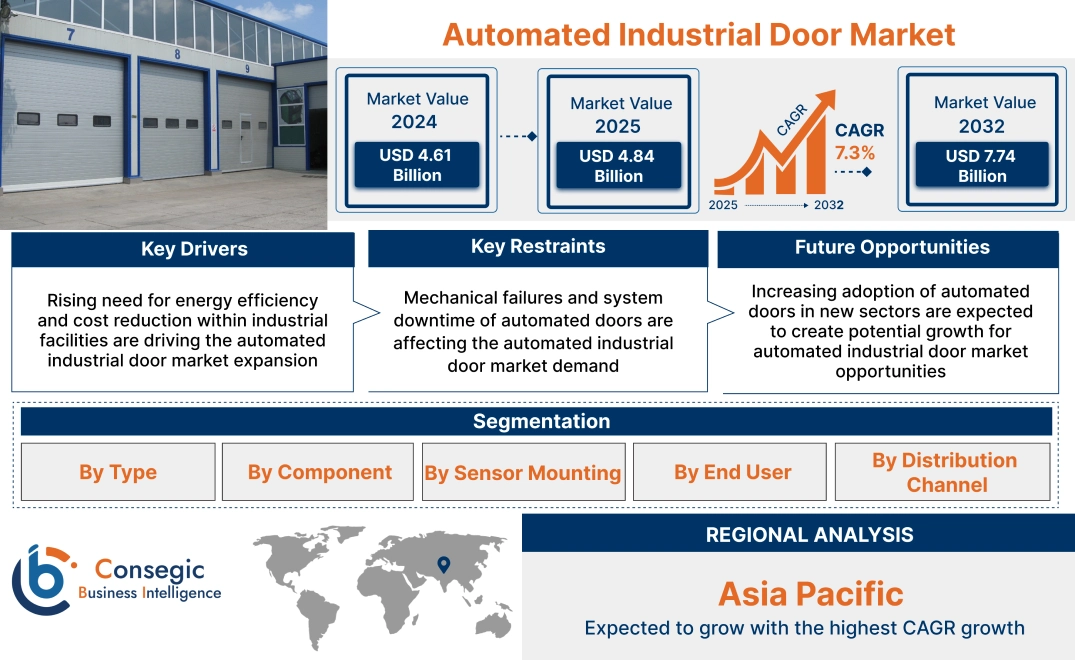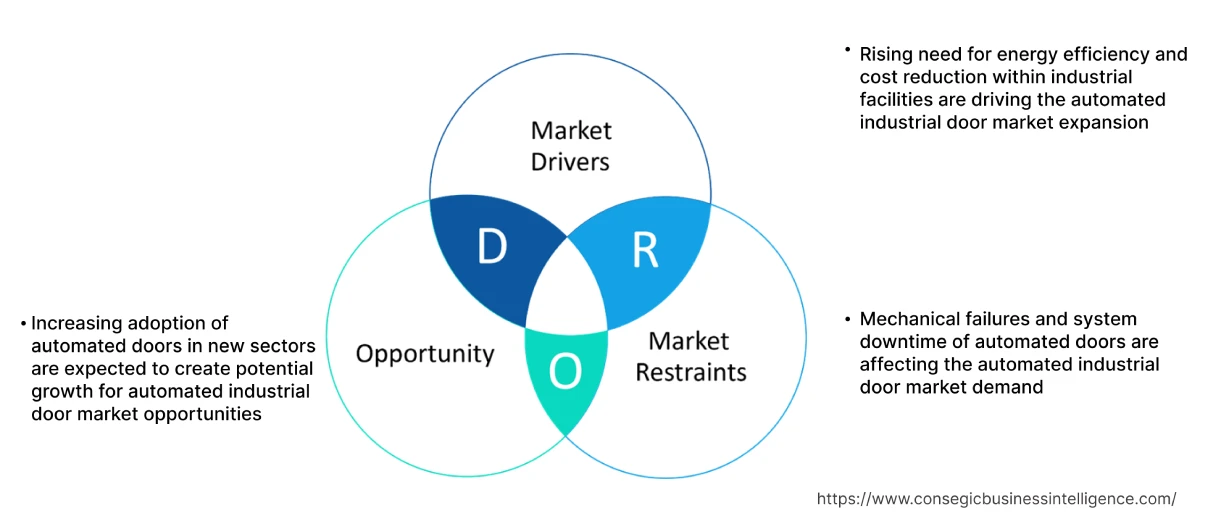- Summary
- Table Of Content
- Methodology
Automated Industrial Door Market Size:
Automated Industrial Door Market Size is estimated to reach over USD 7.74 Billion by 2032 from a value of USD 4.61 Billion in 2024 and is projected to grow by USD 4.84 Billion in 2025, growing at a CAGR of 7.3% from 2025 to 2032.
Automated Industrial Door Market Scope & Overview:
Automated industrial doors are designed to provide seamless access control, improve safety, and streamline operations in various industrial settings, including warehouses, manufacturing facilities, and distribution centers. These doors are equipped with advanced mechanisms such as sensors, motors, and control systems that facilitate automatic opening and closing, thereby reducing the need for manual intervention and minimizing downtime.
Key Drivers:
Rising need for energy efficiency and cost reduction within industrial facilities are driving the automated industrial door market expansion
The rising need for energy efficiency and cost reduction is a significant driver for the global market. Automated doors, particularly high-speed and insulated models, contribute to energy savings by minimizing heat loss and improving temperature control within industrial facilities. By reducing the amount of time doors remain open, these systems help maintain stable indoor climates, which is crucial for sectors such as warehousing and manufacturing where temperature regulation can impact product quality and operational costs.
Energy savings and automated doors help lower overall operational costs by streamlining processes and reducing manual handling. For instance, high-speed doors facilitate quick and efficient movement of goods and personnel, reducing wait times and improving traffic flow. This efficiency translates to decreased labor costs and enhanced productivity. Automated doors also reduce the frequency of door damage and maintenance requirements, further contributing to cost savings over the long term.
- For instance, ASSA ABLOY’s automated doors for hotels, warehouses, and store are designed minimise energy loss, increase natural daylight, and optimise overall energy performance. Energy-efficient doors enhance airflow management and minimize air leaks, helping to maintain a consistent indoor temperature and cut down on energy consumption. Additionally, smart sensors ensure the door opens only when someone needs to go through and closes promptly afterward. This allows users precise control over airflow and energy waste.
Thus, according to the automated industrial door market analysis, the rising need for energy efficiency and cost reduction in industrial facilities are driving the automated industrial door market size.
Key Restraints:
Mechanical failures and system downtime of automated doors are affecting the automated industrial door market demand
The potential for mechanical failures and system downtime is a critical concern in the automated industrial door market. Automated doors rely on complex mechanisms such as motors, sensors, and control systems, which can be prone to malfunctions. Mechanical failures, such as motor breakdowns or sensor inaccuracies, can disrupt the smooth operation of doors, leading to potential safety hazards and operational inefficiencies. These issues can halt production processes, impact workflow, and require immediate attention to minimize downtime.
Further, system downtime due to mechanical failures can have significant financial implications for businesses. The cost of repairs, along with the associated production delays, can lead to substantial losses. Downtime not only affects productivity but also impacts overall operational efficiency, as the affected areas may experience bottlenecks or reduced functionality. Thus, the above analysis depicts that the aforementioned factors would further impact on automated industrial door market size.
Future Opportunities :
Increasing adoption of automated doors in new sectors are expected to create potential growth for automated industrial door market opportunities
The increasing adoption of automated doors in new sectors is driving significant development in the market. In the healthcare sector, automated doors are being increasingly adopted for their hygiene and safety benefits. Hospitals and medical facilities use automated doors to maintain sterile environments and facilitate smooth, touch-free access in critical areas such as operating rooms and laboratories. These doors help prevent the spread of contaminants, support infection control protocols, and improve patient and staff safety. The inclination is expected to continue as healthcare facilities seek to enhance operational efficiency and adhere to stringent health regulations.
Further, the educational sector is also embracing automated doors to improve safety and accessibility within schools and universities. Automated doors offer enhanced security features and ease of access, supporting a safer and more inclusive environment for students and staff. By integrating these systems, educational institutions can manage access to various facilities more effectively, support mobility for individuals with disabilities, and reduce the burden on administrative personnel.
- For instance, in June 2024, ASSA ABLOY delivered automatic door solutions to Madrid hospital, to improve patient flow, hygiene, and sustainability. The hospital selected SW300 swing doors and SL500 sliding doors for operating rooms and intensive care units.
Thus, based on the above automated industrial door market analysis, the increasing adoption of automated doors in new industry verticals are expected to drive automated industrial door market opportunities.
Automated Industrial Door Market Segmental Analysis :
By Type:
Based on type, the automated industrial door market is segmented into sliding door, sectional overhead doors, rapid roll doors, folding hangar doors, and others.
Trends in the type:
- The rising need for space optimization in urban settings is anticipated to drive the segment during the forecast period.
- Warehouses, logistics centers, and manufacturing facilities are embracing industrial doors that not only meet their functional requirements but also contribute to spatial efficiency. It is reshaping the applications of industrial doors, making them essential elements in facilitating smooth operations within an array of industrial environments.
The sliding door segment accounted for the largest revenue share in the year 2024.
- Sliding doors are becoming the preferred choice for industrial facilities, with their sleek design and functionality. They offer an efficient use of space, allowing for larger openings and seamless integration between indoor and outdoor spaces.
- Sliding doors with double or triple glazing, provide excellent insulation, reducing the need for artificial heating or cooling. This energy efficiency lowers utility bills and aligns with the global push towards sustainability and reduced carbon footprint. Manufacturers are capitalizing on this trend by offering sliding doors with improved thermal performance and energy-saving features.
- For instance, in June 2020, ASSA ABLOY Entrance Systems signed a memorandum of understanding with LG Electronics Inc. for home appliances, high-end display devices, and multimedia goods for the development of a high-quality automatic sliding door combined with LG’s OLED digital technology. With this agreement, the companies will develop and offer an automatic sliding door that features a transparent OLED screen.
- Thus, based on the above analysis, these factors are further driving the automated industrial door market growth.
The rapid roll doors segment is anticipated to register the fastest CAGR during the forecast period.
- Rapid roll fast acting doors are designed for high-speed operation, making them suitable for environments where quick access is essential.
- These doors open and close rapidly, reducing wait times and improving workflow in high-traffic areas.
- Their high-speed functionality helps minimize energy loss and maintain temperature control, making them a preferred choice for facilities like distribution centers and manufacturing plants where efficiency and operational speed are critical.
- Thus, based on the above analysis, these factors are expected to drive the automated industrial door market share during the forecast period.
By Component:
Based on component, the market is segmented into operators sensors & detectors, motors & actuators, control panel switches, and others.
Trends in the component:
- The ability to control access remotely and integrate with security systems enhances overall security measures within industrial facilities. As industries continue to prioritize safety and security, the adoption of automated industrial doors is expected to rise.
- The integration of advanced technologies, coupled with the growing need for enhanced safety, security, and efficiency, will drive demand for innovative door solutions.
The operators sensors & detectors segment accounted for the largest revenue in the year 2024.
- Integrating advanced technologies like building management systems, foot traffic detection, and facial recognition into automatic door sensors significantly enhances user convenience and security. This improvement in user experience and safety is a key factor fueling the growing demand for door sensors.
- Automatic door sensors ensure controlled access and movement within buildings, thereby minimizing unauthorized entry and enhancing security protocols. In healthcare facilities, these sensors help maintain hygiene standards by minimizing physical contact, which is crucial in preventing the spread of infections
- The development of low-power sensors has opened new prospects for their application in energy-conscious environments. The ability to seamlessly integrate with security systems and building management systems has further propelled their adoption.
- For instance, Optex designs door sensors that enable automatic operation while ensuring safety. These sensors offer two key functionalities including enhanced safety at the doorway's edge and a wide microwave detection zone to activate the door for forklifts and other vehicles.
- Thus, based on the above analysis, these factors would further supplement the global market share.
The control panel switches segment is anticipated to register the fastest CAGR during the forecast period.
- The increasing number of workplace accidents and stringent regulatory frameworks set by governments worldwide are key growth factors for the segment.
- As industries become more automated, the integration of door switches becomes crucial to maintaining operational safety and efficiency.
- These switches are crucial in environments where machinery operates at high speeds or under hazardous conditions, as they help prevent unauthorized access and equipment malfunctions.
- For instance, in February 2024, Optex Co., Ltd. launched the Clean Wave, a touchless switch that allows users to activate automatic doors by simply waving their hand in front of it. This non-contact design makes the Clean Wave an ideal upgrade for existing switches, enhancing hygiene in environments such as food processing plants, hospitals, and other spaces.
- These developments in the control panel switches are anticipated to further drive the automated industrial door market trends during the forecast period.
By Sensor Mounting:
Based on sensor mounting, the market is segmented into ceiling mount and transom mount.
Trends in the sensor mounting:
- The growing adoption of sensor-based activation (infrared, microwave, ultrasonic) and gesture recognition to minimize physical contact, in industries like pharmaceuticals and food processing is driving the segment.
- The seamless integration of automatic doors with building management systems for centralized control, monitoring, and energy management is driving the segment.
- These factors are anticipated to further drive the automated industrial door market trends during the forecast period.
The ceiling mount segment accounted for the largest revenue share in the year 2024 and it is expected to register the highest CAGR during the forecast period.
- The integration of AI with sensor data allows for predictive maintenance and scheduling based on usage patterns. AI can also optimize door operation for energy efficiency by adjusting opening widths and dwell times based on traffic flow.
- The higher resolution and more responsive safety sensors provide a more comprehensive safety net, particularly for high-speed doors. Some systems offer self-testing capabilities to ensure continuous functionality.
- Doors can communicate with HVAC systems to minimize energy loss during opening and closing. Integration with environmental sensors can trigger door operation based on temperature or other conditions.
- Thus, based on the above analysis, these factors are driving the automated industrial door market growth.
By Distribution Channel:
Based on distribution channel, the market is segmented into direct and indirect.
Trends in the distribution channel:
- Manufacturers and distributors are increasingly leveraging online channels for marketing, sales, and customer support. This includes e-commerce platforms, online product catalogs, and digital marketing strategies.
- Distributors and installers are offering more comprehensive service packages, including consultation, customization, integration with building management systems, and preventative maintenance contracts.
The indirect segment accounted for the largest revenue in the year 2024.
- Manufacturers are increasingly focusing on building long-term, strategic partnerships with key distributors and dealers, providing better support, training, and incentives.
- Intermediaries are adopting digital tools for online catalogs, ordering systems, inventory management, and customer relationship management to improve efficiency and reach.
- To ensure proper installation and maintenance of increasingly complex automatic door systems, manufacturers and distributors are investing more in training and certification programs for their partners.
- Therefore, these the above factors are driving the automated industrial door market demand.
The direct sales segment is anticipated to register the fastest CAGR during the forecast period.
- Direct distribution is favoured for significant industrial, or institutional projects where customization, complex integration, and close collaboration with the manufacturer are essential.
- Direct interaction allows manufacturers to build deeper relationships with their clients, understand their specific needs, and gather valuable feedback for product development.
- Manufacturers are using digital tools like virtual consultations, online product configurators, and direct communication platforms to enhance the customer experience.
- Thus, the above factors are anticipated to drive the market during the forecast period.
By End User:
Based on end user, the automated industrial door market is segmented into warehouse & distribution buildings, factories & manufacturing facilities, and others.
Trends in the end user:
- The growing inclination of automation in industrial processes is a key driver for the adoption of automatic doors. Industries are increasingly investing in automated solutions to streamline operations, improve safety, and reduce energy consumption.
- The increasing investments in pharmaceutical manufacturing and the growing focus on research and development are driving the need for high performance industrial doors in the sector. Further, the need for compliance with stringent regulations and standards is also contributing to the growth of this market segment.
The warehouse & distribution buildings segment accounted for the largest revenue share of 52.99% in the year 2024.
- Industrial doors are used in warehouses, distribution centers, and transportation hubs to facilitate the smooth movement of goods and enhance security.
- The rise of e-commerce and the development of global supply chains are driving the need for advanced door solutions in transportation and logistics facilities.
- Logistics centers rely on high performance doors to facilitate efficient and secure movement of goods, reducing downtime and enhancing operational efficiency.
- Therefore, the above factors are further driving the global market.
The factories & manufacturing facilities segment is anticipated to register the fastest CAGR during the forecast period.
- Modern automated doors are increasingly equipped with sensors, remote monitoring systems, and cloud-based controls, enabling real-time diagnostics and remote operation. This enables better maintenance scheduling, energy optimization, and enhanced security.
- The growing industrial output and infrastructure investments are fueling the need for automated doors in factories & manufacturing facilities.
- Regulatory bodies are prioritizing workplace safety, leading to the adoption of automated doors to enhance security and protect workers in hazardous environments.
- These factors are anticipated to further drive the automated industrial door market expansion during the forecast period.
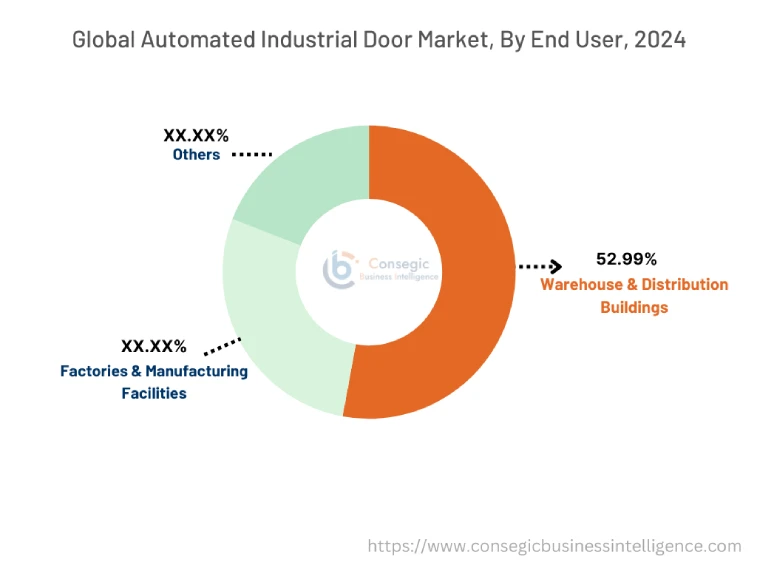
Regional Analysis:
The regions covered are North America, Europe, Asia Pacific, the Middle East and Africa, and Latin America.
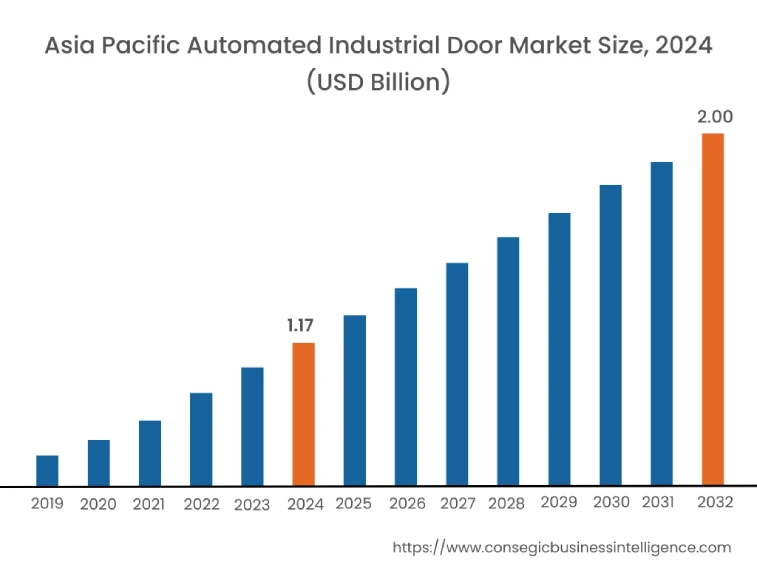
Asia Pacific mobility as a service market expansion is estimated to reach over USD 2.00 billion by 2032 from a value of USD 1.17 billion in 2024 and is projected to grow by USD 1.23 billion in 2025. Out of this, the China market accounted for the maximum revenue split of 36.00%. Countries in the region are experiencing substantial growth in their manufacturing and infrastructure sectors, driving the need for automated industrial door systems. Further, the increasing investment in industrial automation and the development of e-commerce and logistics networks further support the market growth in this region. The Asia Pacific market presents significant opportunities for manufacturers to capitalize on the growing need for advanced and energy-efficient door solutions. These factors would further drive regional automated industrial door market share during the forecast period.
- For instance, in February 2024, NABCO launched NATRUS+e W automatic door system. It incorporates image sensing technology, a sophisticated system that utilizes both infrared and image sensors. This integration results in a larger area of detection for the door's operation.
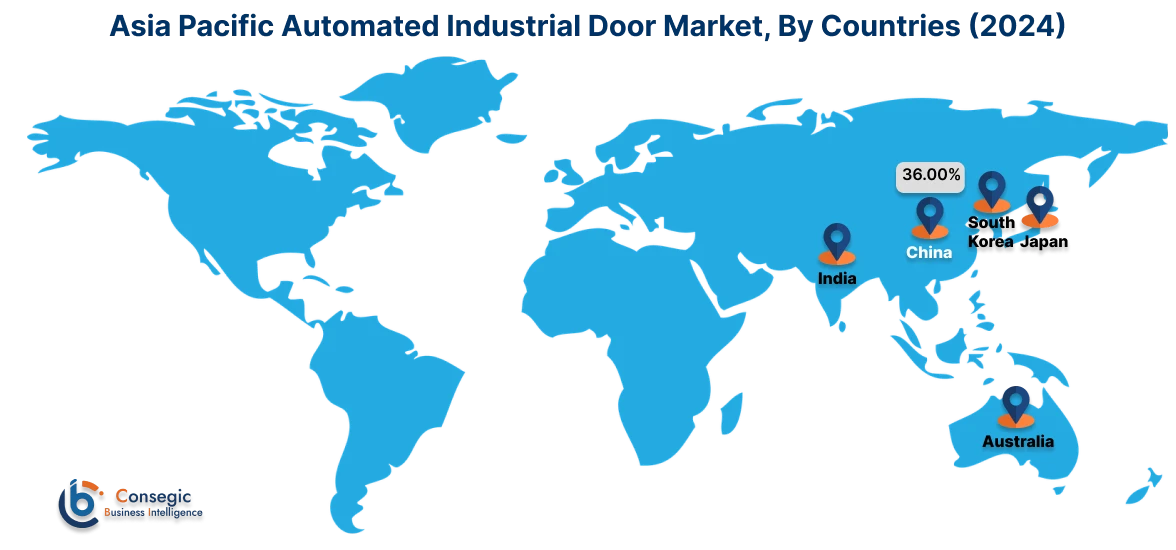
North America market is estimated to reach over USD 2.80 billion by 2032 from a value of USD 1.68 billion in 2024 and is projected to grow by USD 1.76 billion in 2025. North America represents a mature market for industrial door systems, with significant adoption driven by stringent safety and energy regulations. The presence of established manufacturing industries and the focus on automation and advanced security solutions contribute to the demand for industrial door systems in this region. The U.S. and Canada are key markets, with increasing investments in infrastructure development and industrial automation. The North American market is expected to maintain steady growth during the forecast period, supported by technological advancements and regulatory requirements. These factors would further drive the regional market.
- For instance, in June 2023, Record USA has launched a new line of hurricane-resistant sliding doors called the Windcord 5400/5500 series, built to match high safety and performance standards. The Windcord 5400 model can withstand impacts from both large and small debris, earning a Level D or E rating.
Additionally, according to the analysis, the automated industrial door industry in Europe is expected to witness significant development during the forecast period. Countries in the region are focusing on green building standards and energy conservation. Further, the growing trend of smart manufacturing and Industry 4.0 initiatives is further expected to drive the demand for advanced industrial door systems in Europe. Additionally, Latin American region emphasis on advanced manufacturing processes, stringent safety standards, and energy efficiency drives the demand for automated industrial doors. Further, the growing trend of automation in industrial processes is a key driver for the adoption of automatic doors in the Middle East & Africa region. Industries are increasingly investing in automated solutions to streamline operations, improve safety, and reduce energy consumption.
Top Key Players and Market Share Insights:
The global automated industrial door market is highly competitive with major players providing products to the national and international markets. Key players are adopting several strategies in research and development (R&D), product innovation, and end-user launches to hold a strong position in the market. Key players in the automated industrial door industry include-
- Assa Abloy AB (Sweden)
- Hart Door Systems (U.K.)
- Gandhi Automations Pvt Ltd (India)
- AI-Barrack Industrial Group (Saudi Arabia)
- Maviflex (France)
- RTJ Automation & Maintenance Limited (U.K.)
- Gilgen Door Systems AG (U.K.)
- Novoferm GmbH (Germany)
- Casit Srl Turin (Italy)
- TORMAX (Switzerland)
Automated Industrial Door Market Ecosystem:
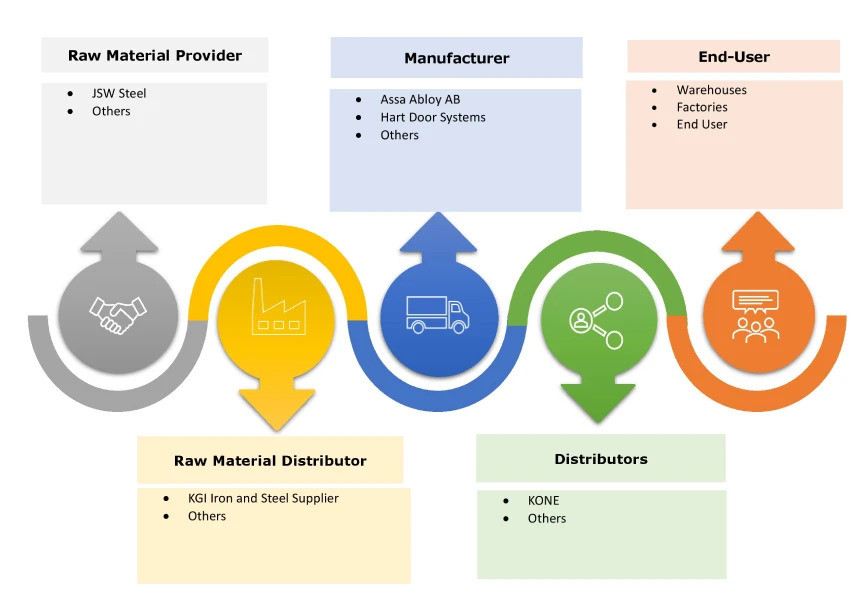
Automated Industrial Door Market Report Insights :
| Report Attributes | Report Details |
| Study Timeline | 2019-2032 |
| Market Size in 2032 | USD 7.74 Billion |
| CAGR (2025-2032) | 7.3% |
| By Type |
|
| By Component |
|
| By Sensor Mounting |
|
| By End-User |
|
| By Distribution Channel |
|
| By Region |
|
| Key Players |
|
| North America | U.S. Canada Mexico |
| Europe | U.K. Germany France Spain Italy Russia Benelux Rest of Europe |
| APAC | China South Korea Japan India Australia ASEAN Rest of Asia-Pacific |
| Middle East and Africa | GCC Turkey South Africa Rest of MEA |
| LATAM | Brazil Argentina Chile Rest of LATAM |
| Report Coverage |
|
Key Questions Answered in the Report
How big is the Automated Industrial Door Market? +
Automated Industrial Door Market Size is estimated to reach over USD 7.74 Billion by 2032 from a value of USD 4.61 Billion in 2024 and is projected to grow by USD 4.84 Billion in 2025, growing at a CAGR of 7.3% from 2025 to 2032.
Which is the fastest-growing region in the Automated Industrial Door Market? +
Asia-Pacific is the region experiencing the most rapid growth in the market.
What specific segmentation details are covered in the Automated Industrial Door report? +
The mobility as a service report includes specific segmentation details for type, component, sensor mounting, end user, distribution channel, and region.
Who are the major players in the Automated Industrial Door Market? +
The key participants in the market are Assa Abloy AB (Sweden), Hart Door Systems (U.K.), Gandhi Automations Pvt Ltd (India), AI-Barrack Industrial Group (Saudi Arabia), Maviflex (France), RTJ Automation & Maintenance Limited (U.K.), Gilgen Door Systems AG (U.K.), Novoferm GmbH (Germany), Casit Srl Turin (Italy), TORMAX (Switzerland), and others.
